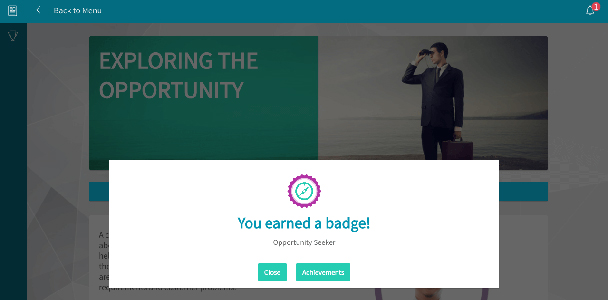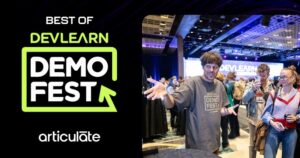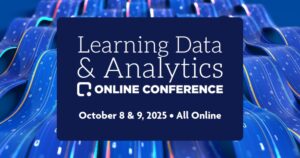So you’ve been to an industry event anddiscovered that all’s right with the world of eLearning. How tantalizing thosebest-in-class, high-budget solutions you saw showcased there! But if this were acar you were being shown, you might want to lift the hood. What’s underneathmight differ dramatically from the gleaming exterior.
The reality is that most eLearning designis still stuck in the 1990s. Isn’t it time that we could easily replicate the typeof online or app experience that most of us now take for granted outside theworkplace? And why hasn’t this happened already?
The (non-)trickle-down effect
We all think we have a fair idea of whatgood digital learning experiences should be like. But this thinking isn’tfiltering down to people on the ground—those hard-pressed L&D personnel whoneed to be able to satisfy a simple training need quickly and efficiently.
And our research in learning science isn’tfiltering down, either. Why? Because we haven’t yet made the implications ofour findings practical enough to apply. Your average L&D person might, justmight, have heard of cognitive load, cognitive dissonance, spaced practice,multimedia learning principles, etc., but knowing about them is a world awayfrom building content that puts this knowledge to use. Often, it’s less a caseof not having the knowledge than of not having the time.
I have written before for Learning Solutions Magazine about the state of eLearning. Despite initiatives such as the Serious eLearning Manifesto and thegreat work done by The eLearning Guild to support practitioners, the goodpractice of the few isn’t yet reaching the many. New clients who are seeking adifferent approach to training and who are genuinely interested in eLearningwill routinely tell us that:
- They have “tried eLearning before”—andthey can’t shake off their dread of poor-quality content
- They are worried that creatinggreat content will be too costly and take too long
Going against the grain of how people naturally learn
If I wake up wanting to learn about anysubject on earth, I have hundreds of options available to me. I can download anapp to my smartphone, Google away to my heart’s content, or search for an onlinecourse or community to support me in my learning. This accessible, technology-savvyway of learning is the one that feels most “natural” to us nowadays. Yet, when designingcorporate eLearning, developers and subject matter experts will spend months poringover the minutiae of the perfect image, words, or animation to explain eachconcept—a staid, inflexible, ponderous process. So what is to be done?
We need to adopt a new attitude towarddigital learning content—a term I use deliberately, as it more accuratelydescribes how we learn now, in this information-abundant digital world. Thechallenge lies not in designing perfect new content each time we have a trainingrequirement, but in figuring out how to pull content together in a bundle thatbest facilitates learning. Of course, we will still need new content, but itshould be shaped to yield the best results: ideally short, focused snippetstargeting the most difficult concepts.
Anyone out there who retains a preferencefor old-style click-next eLearning, beware: Your staff never wanted it, andsoon they won’t put up with it. A perfect storm of cognitive dissonance iscoming, and it will sweep your preference away.
A briefer history of eLearning
The evolution of eLearning authoring tools closelyaligns with the quality of eLearning content in the industry. The eLearning qualitygraph in Figure 1 is my own unscientific but experience-basedrepresentation of how we have changed and developed over recent decades.

Figure1: A representation of eLearning quality in recentdecades
In the 1990s, eLearning quality slowlyimproved as we moved from static CD-ROM content to more dynamic, HTML-drivenlearning experiences. As Internet bandwidth increased, multimedia elements camemore to the fore. We had a brief dip in the 2000s with issues around thecollapse of dot-com organizations. As the Internet stabilized, we saw a greatervariety of eLearning authoring tools, and for the first time you could use morethan one virtual class tool.
The next big leap came in the 2000s when“rapid eLearning” burst onto the scene—suddenly everyone was creating contentand sharing their ideas. But bad ideas can be shared as easily as good ones!Only in the last few years have we begun to kick the habit of dependence onrapid eLearning tools, which spawned so many identikit click-next courses.
The big difference now is that people havegrasped that we need a more holistic view of eLearning—not as a single type oflearning experience or learning content, and not as the privileged preserve of largeorganizations with large budgets!
New and better tools lead to new attitudes
In my team’s current work, we are implementingan approach to eLearning that supports the way that people naturally learn. Ouraim is to take advantage of the possibilities offered by some new authoringtools and bring together curated content, stories, and original interactivecontent alongside a well-designed gamification layer (Figure 2). As marriagesgo, this one is made in heaven!

Figure2: A holistic view of eLearning incorporatesmultiple types of learning experience and content
Quests and ecosystems
In a “learning quest,” learners are insidean organizational narrative that challenges them to learn new skills as theyprogress. The quest can be anything that embodies the overall aim of thetraining, whether that is supporting culture change or simply keeping staff ontrack with compliance issues.
There really is no excuse for pooreLearning anymore, regardless of budget. We have interactive video, easilycreated animations, interactive templates, gamification possibilities, and more.High-impact, low cost-per-head eLearning isn’t only possible, it just has to happen.
Example: Changing the culture of product developmentwithin an organization
Figures 3, 4, and 5 are screenshots thatillustrate the concept of a learning quest. These are taken from an example oftraining to empower all staff in an organization to contribute to new productdevelopment. The sequence of activities in the quest is based on the sales andproduct development process (the organizational narrative) and includes aseries of conversations and challenges for staff to complete. As differentchallenges are completed, new content and additional challenges are madeavailable—depending on the learner’s path through.

Figure3: In a learning quest, visual cues establishcontext and motivate sustained progress

Figure4: Challenges during a learning quest proactivelyengage learners in conversations and situations

Figure 5:Badges provide acknowledgment of achievement and progress within the quest, as wellas an organizing framework for the quest
To create this new type of learningexperience, we need to think beyond the single-use eLearning authoring tool. Weneed no less than an authoring ecosystem. I know that the term “ecosystem” hasbeen in circulation for a while in relation to learning—it evokes notions of theend-user concept of staff wanting to access different types of content in asingle sign-on environment. Well, the ecosystem concept applies to content creation,too. What if we had an authoring environment where we could plug and play differenttypes of specialist content creation tools—and not only eLearning-specific ones?For example, we could use best-in-class tools from marketing andcommunications, content curation, gaming, and virtual reality. This is themodel we use at Logicearth to createour learning quests.
Getting started with learning quests
If you want to get started with a learningquest approach to delivering and supporting training within your organization, askyourself these five questions:
- Where can I find existing content that would help my staff (e.g., MOOCs,TED talks, online industry forums)?
- What are my staff currently doing well, and how can I capture andshare that?
- Where do my staff have the most difficulty? What mistakes ormisunderstandings have the biggest impact in my organization?
- How can I come up with activities that will encourage discussion, engagement,challenge, and collaboration? What do staff need to practice the most?
- What new content do I needto create?
And remember—we are social animals
It’s only in the fifth question above thatwe start to look at creating new content. If you work in a large organization,you’ll already have access to a huge (probably untapped) source of content—yourstaff. How many of us take the time to capture and share what is already knownabout a given subject in an organization? We now have the tools to do this, so noexcuses. We have found that our learning quests inevitably include a sociallayer that becomes part of the rich learning content for each training topic. Tofacilitate this, we encourage development staff to blog—writing, posting avideo, and asking and answering questions.
Workplacelearning is all about continuous improvement. Next-generation eLearninginvolves moving away from being a single piece in a jigsaw puzzle toward beingthe picture itself—multifaceted, modern, and a little bit magical, too.






